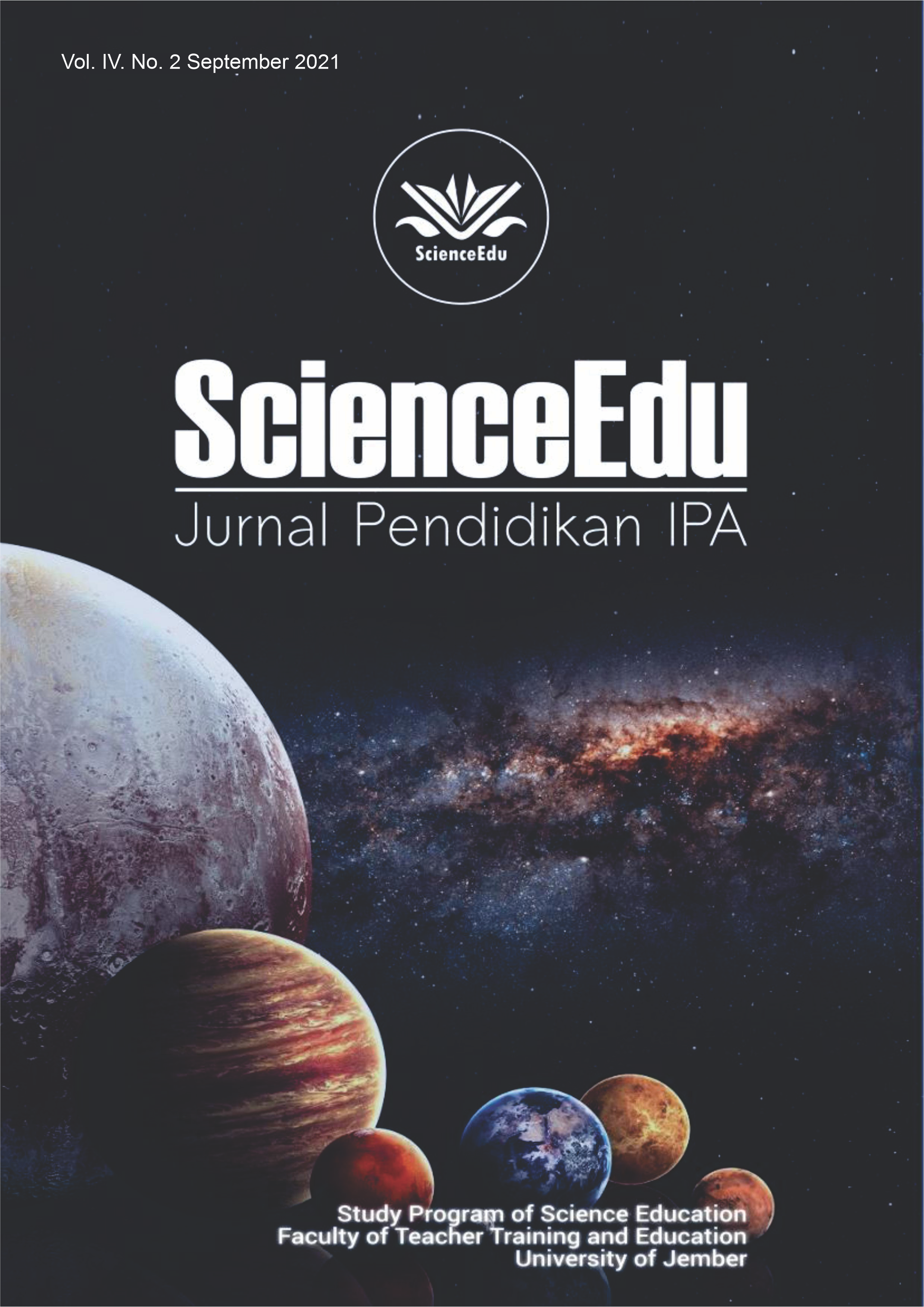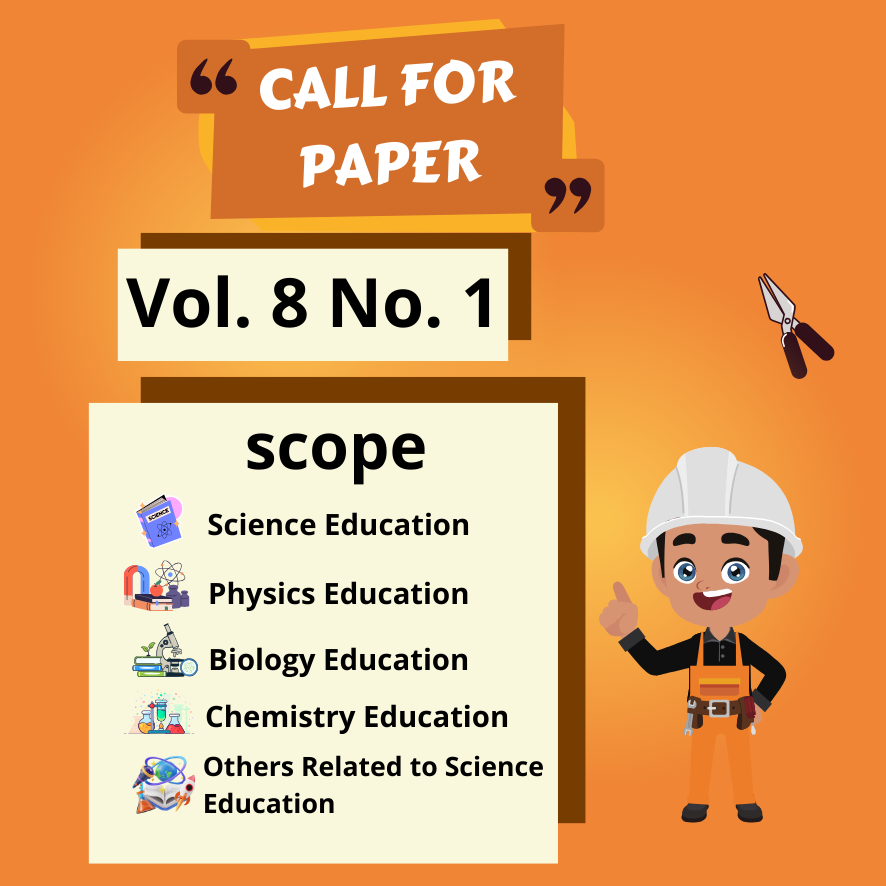IDENTIFICATION OF CRITICAL THINKING CAPABILITIES OF HIGH SCHOOL STUDENTS USING THE INTEGRATED PHYSICS MODULE OF ENGINEERING DESIGN PROCESS (EDP)
DOI:
https://doi.org/10.19184/se.v4i2.28416Keywords:
Critical Thinking, Engineering design process, GenderAbstract
The Indonesian curriculum states that science education is one of the efforts to improve the quality of people's lives to be able to have knowledge and skills in solving problems. Problem solving skills require capable critical thinking skills to be able to analyze, assess and reconstruct the knowledge they have to solve problems. In addition, the ability to think critically is an important aspect that must be developed according to the competence of 21st-century skills. This research is a type of qualitative research with a case study approach to identify students' critical thinking skills using the Engineering design process (EDP) integrated physics module which is differentiated by gender. The subjects of this study were six students, each consisting of three male students and three female students in class XI MIPA 2 at MAN 1 Jember. The data was collected in the form of observation data, documentation, and interviews. The data collected will be reduced, analyzed based on indicators of critical thinking skills, and presented to then draw conclusions. All data obtained will be tested for validity using triangulation techniques. The results of the identification of critical thinking skills indicate that there are differences in the characteristics of the problem-solving process between male and female students. Female students are better at interpreting problems accurately and in detail than male students. Meanwhile, male students dominate in giving ideas, and even though some ideas are not quite in accordance with the concepts of physics, and are still in doubt. Overall, there is no significant difference between the critical thinking abilities of male and female students. All students tend to still not fully understand the physics concepts related to solutions so that the statements and opinions given regarding solutions tend to be less clear and less logical.
Downloads
References
Arikunto, S. (2010). Research Procedures A Practical Approach. Jakarta: Rineka Cipta.
Cruischack, D. R. (2014). Teaching Behavior Issue 6. Jakarta: Salemba Humanika.
Damopoli, I., Yohanita, A. M., Nurhidaya, N., & Murtijani, M. (2018). Improving Science Process Skills and Student Learning Outcomes Through Inquiry-Based Learning. Journal of Bioeducation, 6(1), 22–30.
Firmanti, P. (2017). Reasoning of Male and Female Students in Mathematics Learning Process. HUMANISMA: Journal of Gender Studies, 1(2), 73-85.
Fitriani, D., Kaniawati, I., & Suwarma, I. R. (2017). The Effect of STEM-Based Learning (Science, Technology, Engineering, and Mathematics) on the Concept of Hydrostatic Pressure on the Causal Reasoning of Junior High School Students. In Proceedings of the National Seminar on Physics (E-Journal), 6, pp SNF2017-EER).
Krajcik, J., & Ibrahim, D. (2017). Engaging Learners in STEM Education. Eesti Haridusteaduste Ajakiri, 5(1), 35–58.
Kurniasih, A. W. (2010). The Leveling of Critical Thinking Skills for Students of Mathematics Education Study Program FMIPA UNNES in Solving Mathematics Problems. Proceedings of the National Seminar on Mathematics and Mathematics Education Yogyakarta.
Kurniawati, D. I. (2019). Development of Problem-Based Kinematics Teaching Material to Improve Students' Critical Thinking Skills. JIPF (Jurnal Ilmu Pendidikan Fisika), 4(1), 21-27.
Lestari, P. D., Sudarti, & Supriadi, B. (2016). Development of GASING-Based Contextual Physics Learning Module (Easy, Fun, Fun) on Temperature and Heat Materials in High School. Jurnal Pembelajaran Fisika, 5(3), 97-107.
Mhlanga, M. T. (2017). Student's Critical Ability in Solving Mathematics Problem Based on Gender Differences. International Journal of Science Arts and Commerce, 2(1), 67-74.
Moore, T. J., Stohlmann, M. S., Wang, H. H., Tank, K. M., Glancy, A. W., & Roehrig, G. H. (2014). Implementation and Integration of Engineering in K-12 STEM education. In Åž. Purzer, J. Strobel, & M. Cardella (Eds.), Engineering inprecollege settings: Research into practice. West Lafayette: Purdue Press.
Prastowo, A. (2014). Creative Guide to Making Innovative Teaching Materials. Yogyakarta: DIVA Press.
Riska, K., & Kurniawati, A. (2018). Analysis of Students' Difficulties in Solving Math Story Problems with Fractions Viewed from Gender. Jurnal Teori dan Aplikasi Matematika, 2(2), 118-122.
Sari, R. 2016. Metacognition Activities in Solving Mathematics Problems in terms of Gender of Class VII Students of SMP Negeri 1 Nanggulan Kapubaten Kulon Progo. Jurnal Pembelajaran Matematika, 4(5), 496-509.
Scriven, M., & Paul, R. (2013). Defining Critical Thinking. http://www.criticalthinking.org/pages/defining-critical-thinking/410 (accessed on 07 October 2020).
Sukayasa. (2014). Reasoning Characteristics of Middle School Students in Solving Geometry Problems in terms of Gender Differences. Jurnal Pendidikan Matematika, 3(1).
Suwindra, I. N. P., Sujanem, R. & Suswandi, I. (2012). Development of Interactive Multimedia Software Modules with Problem-based Learning Strategies to Improve Understanding of Physics Concepts and Learning Outcomes for Class XII High School Students. Jurnal Pendidikan Indonesia, 1(1), 13-27.
Syukri, M. (2018). The Impact Of Engineering Design Process In Teaching And Learning To Enhance Students' Science Problem-Solving Skills. JPII (Jurnal Pendidikan IPA Indonesia), 7(1), 66-75.
Wahyuni, S. (2011). Developing Students' Critical Thinking Ability Through Science-Based Learning Problem Based Learning. http://repository.ut.ac.id/2491/1/fmipa/201146.pdf (accessed on 07 October 2020).
Wijaya, I. P. H., Sujadi, I., & Riyadi, R. (2016). Mathematical Communication Skills of Students According to Gender in Problem Solving on Blocks and Cubes (Case Study on Class VIII Junior High School Students of Al-Azhar 29 Islamic Middle School Semarang). Jurnal Elektronik Pembelajaran Matematika, 4(9), 778-788.
Yin, K. R. (2018). Case Study Design and Method. Jakarta: PT. Raja Grafindo Persada.



